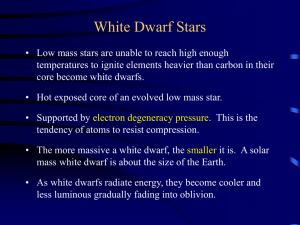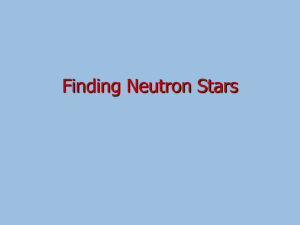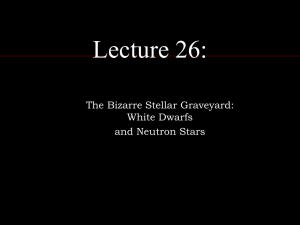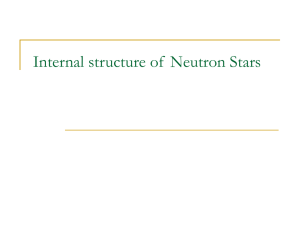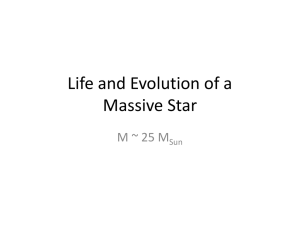Neutron Stars
advertisement
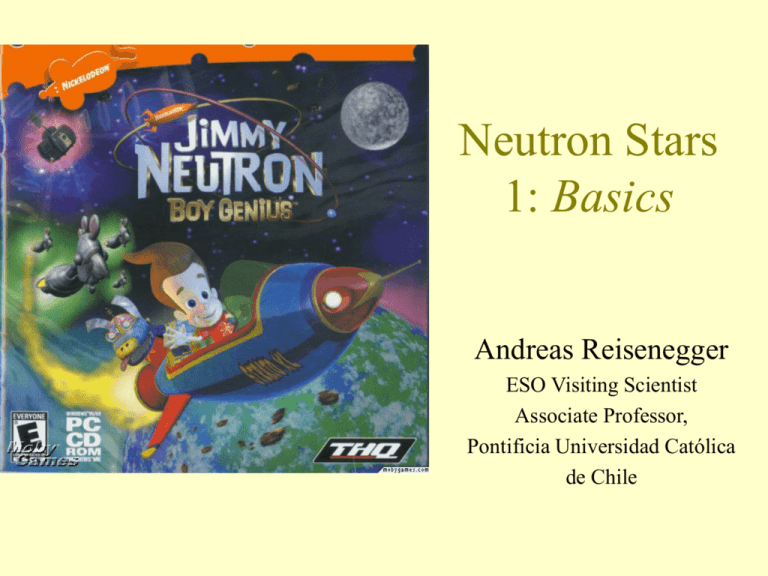
Neutron Stars 1: Basics Andreas Reisenegger ESO Visiting Scientist Associate Professor, Pontificia Universidad Católica de Chile Outline of the Lecture Series 1. Basics: Theory & history: prediction, discovery, etc. 2. Phenomenology: The many observational “incarnations” of NSs & what we can learn from them 3. Thermal evolution: Cooling & heating mechanisms, expected thermal history, obs. constraints & what they tell us about nuclear physics & gravity 4. Magnetism: Determination of NS magnetic fields, their origin, evolution, and related physical processes Outline of Lecture 1 • Degenerate fermions, white dwarfs, & Chandrasekhar mass • Prediction of neutron stars, main predicted properties • Pulsar discovery & interpretation Bibliography - 1 • Stuart L. Shapiro & Saul A. Teukolsky, Black Holes, White Dwarfs, and Neutron Stars, Wiley (1983): quite outdated on the phenomenology, but still the most comprehensive and pedagogical discussion • Richard R. Silbar & Sanjay Reddy, Neutron Stars for Undergraduates, Am. J. Phys. 72, 892-902 (2004; erratum 73, 286, 2005), nucl-th/0309041: how to build simple numerical models of neutron stars • James M. Lattimer & Madappa Prakash, The Physics of Neutron Stars, Science, 304, 536 (2004): review • Norman K. Glendenning, Compact Stars: Nuclear Physics, Particle Physics, and General Relativity, Springer (1997): quite theoretical Bibliography - 2 • Kip S. Thorne, Black Holes & Time Warps: Einstein’s outrageous legacy, Norton (1993): entertaining popular history of the idea of compact stars & black holes • Bernard F. Schutz, A first course in general relativity, Cambridge (1985): rigorous, but elementary account of GR from the basics up to relativistic stars, black holes, & cosmology • Soon to appear: P. Haensel, A. Y. Potekhin, & D. G. Yakovlev, Neutron Stars 1: Equation of State and Structure (2006) Pauli principle Fermions: • particles of half-integer spin (½, 3/2, ...): – electrons, protons, neutrons... • obey Pauli exclusion principle (1925): No more than 1 fermion can occupy a given orbital (1-particle quantum state) “Fermi-Dirac statistics” Ground state of fermion system Ground state (T=0) has all particles in the orbitals of the lowest possible energy Fermi sphere in momentum space: | p | pF Each orbital has a phase-space volume x y z px p y pz h3 Ground state of system of N fermions of spin ½ (sz = ½) in a spatial volume V (“box”): N h3 4 V pF3 2 3 pF (3 2 n) 3 , n 1 N V m Degeneracy pressure • Fermi energy: – – – – Max. fermion energy @ T= 0 Also chemical potential of the system: F = (T= 0) General: F (mc 2 ) 2 pF2 c 2 2 2 Non-relativistic limit, pF<<mc: mc2 pF (3 2 n) 2 3 F 2m 2m F pF c c(3 2 n)1 3 • Total energy E: Sum over Fermi sphere (all particles) • “Degeneracy pressure” P: – Extreme relativistic limit, pF>>mc: E P P ( n) P ( ) – Through kinetic theory or thermodynamics V N – Non-zero value at T=0 1 2 23 53 2 13 43 – Non-relativistic P (3 ) n Extreme relativistic P (3 ) cn 4 5m • Zero-temperature limit is good approximation as long as kT << F – Thermal effects are only a small correction for white dwarfs & neutron stars White dwarfs dP GM 2 dr r Hydrostatic equilibrium Non-relativistic electron degeneracy pressure Combining, GM 2 P~ R4 (3 2 ) 2 3 n 5 3 2 3 M P ~ 5me me mi R 3 53 2 3 1 3 4 3 R~ M ~ 10 km ~ 1 ton cm Gme mi5 3 white dwarfs get smaller (denser & more relativistic) as M increases Relativistic electrons M 1 P (3 2 )1 3 cn 4 3 ~ c 3 4 mi R 43 Combining with hydrost. equil. unique mass M Chandrasekhar (Chandrasekhar 1931) (c G )3 2 ~ 1.4M Sun 2 mi Neutrons 1932: James Chadwick discovers the neutron. Neutrons: decay or not decay? • In vacuum (lab), neutrons decay with half-life ~ 15 min: n p e e • In very dense matter, neutrons are stable (don’t decay) because low-energy proton & electron orbitals are already occupied • “Chemical” (weak interaction) equilibrium n pe n p e • Around nuclear density, neutrons coexist stably with a much smaller number (~1%) of protons & electrons (fraction density-dependent & uncertain) • At higher densities, strong interactions among particles are difficult to model, making the state of matter (& eq. of state) more & more uncertain. Baade & Zwicky (1934): “With all reserve we advance the view that supernovae represent the transition from ordinary stars into neutron stars, which in their final stage consist of extremely closely packed neutrons.” Supernova 1987A (23 Febr. 1987) in the Large Magellanic Cloud: before & after Collapse Collapse of stellar core huge density forces p + e n + Neutrinos () escape: a few detected 2 hours before the light of SN 1987A. Neutrinos BUT: No neutron star found! Remnant Neutron stars • First approximation: Self-gravitating ball of noninteracting neutrons at T=0 • Recall non-relativistic white dwarf: 2 3 1 3 4 3 R~ M ~ 10 km ~ 1 ton cm Gme mi5 3 • Neutron star (by analogy / scaling): 2 3 1 3 9 3 R~ M ~ 10 km ~ 10 ton cm Gmn8 3 Derived quantities Assume M M Chandra 1.4M Sun , R 10 km • Surface gravity g • Escape speed GM 11 2 10 g Earth 2 R vesc 2GM R 0.6 c • “Breakup” rotation • Schwarzschild radius Kepler GM R3 2 2 kHz 2 (0.5 ms) RSchw • “Relativity parameter” 2GM 4 km c2 2 2 | Wgrav | 2GM RSchw vesc 0.4 c2R R Mc 2 c Mass reduction ~ 20% when NS forms (carried away by neutrinos, perhaps gravitational waves) • Gravitational redshift factor 2GM 1 z 1 2 c R 1 2 1.3 Relativistic stellar structure eqs. Since P=P() only (no dependence on T, equilibrium composition), these two equations are enough to calculate the NS or WD structure. dL/dr=..., dT/dr=... are important only for the thermal evolution. First (numerical) solution for NSs: Oppenheimer & Volkoff 1939 The state of matter changes with density (T 0): • “Ordinary” solid • Solid + neutrons • npe liquid • More exotic particles: – – – – muons mesons , hyperons , ??? • Quark matter? Massradius relation for NSs Black (green) curves are for normal matter (SQM) equations of state. Regions excluded by general relativity (GR), causality, and rotation constraints are indicated. Contours of radiation radii R are given by the orange curves. The dashed line labeled I/I = 0.014 is a radius limit estimated from Vela pulsar glitches (27). from Lattimer & Prakash 2004 Expected thermal radiation • Neutron stars are born in stellar core collapse: initially very hot, expected to radiate thermally (~ blackbody) (Chiu 1964, Chiu & Salpeter 1964) L 4 R T 2 4 T 1.5 10 L LSun K ~ 0.1keV 6 14 • Might be detectable in soft X-rays (difficult) • Start of X-ray astronomy (Giacconi et al. 1962): – several sources (quasars, etc.) – growing theoretical interest in NSs – at first no unambiguous detections of NSs (X-ray pulsars found by UHURU, 1971) – no detections of pure, thermal radiators until much later Pulsars: discovery 1967: PhD student Jocelyn Bell & her supervisor Anthony Hewish detect a very regular Pulsating Source of Radio (PSR 1919+21) with P=1.377 s, initially “LGM 1”. http://www.jb.man.ac.uk/~pulsar/Education/Sounds/sounds.html Pulsar in the Crab nebula (remnant of SN 1054) Lyne 2000 How we know pulsars are NSs • Association with supernova remnants (SNRs) 3 • Rotation of Crab pulsar GM R 4 G 3 3 2 11 g 10 4 G cm 3 – Much faster ones (“millisecond pulsars”) found later • Energy budget of SNR in rough agreement with energy lost from rotating NS. • Very high-energy (non-thermal) emission: likely relativistic system • Thermal emission (X-rays): emitting region 10 km • Binary systems: Precise masses 1.25-1.45 Msun ~ MChandra Masses of pulsars in binary systems Fig. by I. Stairs, reproduced in Lorimer 2005 Franco Pacini “Tommy” Gold Known pulsars: ~ 2000 Other neutron stars Several other classes of observed objects are also believed to be NSs: • X-ray binaries (some NSs, some black holes) • “Soft gamma-ray repeaters” & “Anomalous X-ray Pulsars” “Magnetars” • Thermal X-ray emitters: – bright central objects in SNRs – fainter, isolated objects • Radio transients (RRATs) See tomorrow’s Lecture for details...
